From the Art Gallery with Love x
Julia Letts & Sarah Millin
The Art of Isolation
2020
The Art of Isolation is a joint project between two Worcestershire creative practitioners: Julia Letts who has a background in oral history and recording people’s stories, and artist Sarah Millin. The pair joined forces as part of Worcester City Art Gallery & Museum’s From the Art Gallery with Love project, bringing culture to the community online during 2020.
This is a series of short digital films reflecting on aspects of isolation for different people in Worcestershire. Julia and Sarah were influenced by the collections of the Worcester City Art Gallery & Museum, in particular the depictions of nature and artefacts related to the natural world.
“We wanted these stories either to mirror the experiences of others in the county or to offer comfort, solace and inspiration.”
The full recordings were, on average, 45 minutes long but short extracts from the recordings were edited by Julia and illustrated by Sarah to form a series of uplifting and beautiful films which can be viewed below. The City Art Gallery is delighted to have formally acquired the recorded stories into the museum collections as a record of ordinary people’s experiences during the early days of the Covid-19 pandemic.
Explore the stories below and find out more about the people behind them.
Sue’s Story
The Art of Isolation: Sue’s Story, edited by Julia Letts & illustrated by Sarah Millin, 2020.
Copyright the artists
Julia & Sarah say: “Our first film is called Sue’s Story and we wanted to tell it for several reasons. Sue was born in Pershore, and after living elsewhere for some years, has come back to Pershore. Sue lives on her own and is over 70 so when lockdown was announced in March, she was in the category of people told to isolate for 12 weeks. As a busy person with several volunteering roles and grandchildren living nearby, this came as a shock. At first, she says, she felt written off and worthless…
Read more
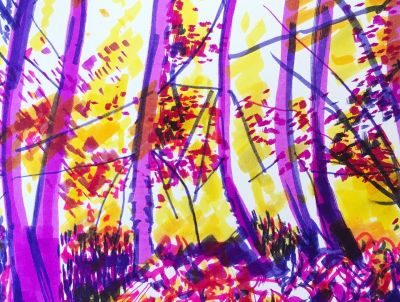
Sue’s outdoor space is limited so she decided to make the most of her ‘hour of exercise’ and went for long walks in the surrounding countryside. She watched spring merge into summer, blossom and bluebells come and go, and the natural world carry on as normal.
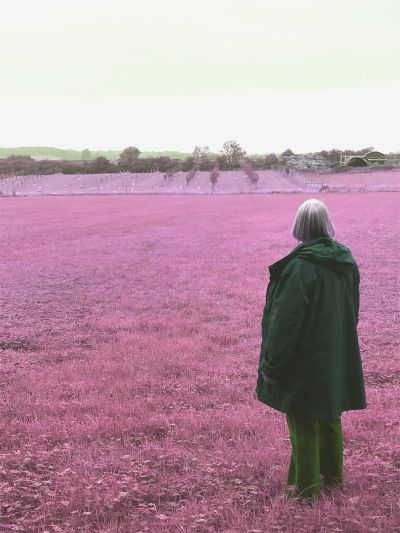 We chose Sue’s story as it represented what a lot of people experienced in those early, bright days of lockdown. A tragedy was unfolding on our TVs and in our hospitals but for many people, life in lockdown was an enforced chance to slow down, take stock and in Sue’s words, ‘have the time to do what I wanted to do without feeling guilty’.”
We chose Sue’s story as it represented what a lot of people experienced in those early, bright days of lockdown. A tragedy was unfolding on our TVs and in our hospitals but for many people, life in lockdown was an enforced chance to slow down, take stock and in Sue’s words, ‘have the time to do what I wanted to do without feeling guilty’.”
As well as exploring outdoors, Sue also had time to explore her creative side. Not only did she collect interesting things – wood, stones, seed heads, and skulls (for her grandson’s bone collection) – she also started doing crochet and knitting projects, linking up with creative people all over the world via the internet, and making an intricate and beautiful blanket and several cushions.
Sue’s isolation was a positive experience, a chance for her to be herself.
Interviewing Sue was the first face-to-face interview that Julia had recorded in 4 months and was done outside in a barn, where Sue and Julia were joined by a very vocal robin.
Listening to Sue’s story made Sarah think of how sunlight influences colours as she experimented with purples and yellows to create the image of hazy sunshine between trees. She enjoyed drawing nature using mixed media including print, paint and pastel and had her first go at using her ipad to animate elements of the illustration.
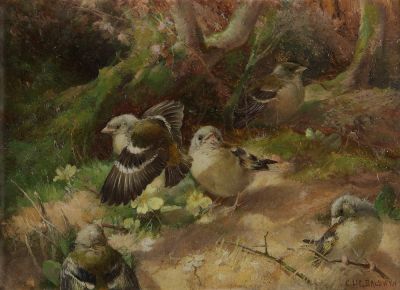
Charles Baldwyn – In Happy Woodland, c.1899–1900. C. Worcester City Museum Collections
Julia and Sarah were conscious of contrasts and links between documenting Sue’s views on the power of nature in 2020 with the paintings of 18th and 19th century artists in the collections of the Worcester City Museum and Art Gallery. Sue’s story brought to mind In Happy Woodland by Charles Baldwyn.
Thelma’s Story
The Art of Isolation: Thelma’s Story, edited by Julia Letts & illustrated by Sarah Millin, 2020.
Copyright the artists
Thelma comes from a small village in County Wexford, Ireland. When she first moved to the UK she worked in pubs, but 12 years ago she decided to retrain as a care worker and has never looked back. We wanted to tell Thelma’s story because lockdown for her was a particularly busy and challenging time. She became totally focused on combating isolation and making sure that the people in her care were getting out of their rooms and joining in with activities.
Read more
Thelma works at Fernhill House in Fernhill Heath where she’s the Activity Coordinator. She’s full of energy and brilliant ideas and loves her job. So when her residents saw scary reports about the virus on TV and radio and wanted to stay in their rooms, Thelma needed to find a way to coax them out. During lockdown she had to re-think all her activities. Watching Formula One on TV was replaced by ‘The Whacky Races’ with staff and residents racing in wheelchairs around the grounds. Walks around the village were replaced by walks in the gardens and planting raised beds and flowerpots. Regular church services with the local vicar were replaced by ones run by Thelma, something she’d never done but were ‘brilliant for them and for me’.
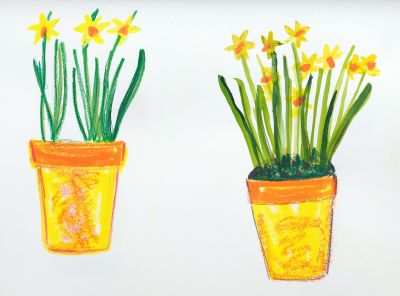
Thelma’s story was full of light and joy. An enticing image for us was the mobile sweet shop she set up, a trolley laden with old-fashioned sweets dished out to residents in pink striped bags. Another was the garden springing to life under the residents’ care. And then there was Thelma’s description of learning to smile with your eyes – so important when wearing a mask all day long.
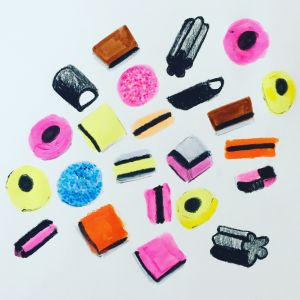
Listening to Thelma’s story made Sarah think of bright colours, rainbows and joy. She continued to learn new skills in animation and video using a range of media, such as ink, paint, pastel and digital. There was a good excuse to buy lots of old-fashioned sweets (for research purposes only of course!) and a bunch of dahlias given to Sarah by a stranger at her allotment provided inspiration for some of the flower illustrations.
Julia and Sarah had been struck by the painting Wet Rainbow by Patrick Hughes in the summer exhibition A Welcome View shown at Worcester City Art Gallery & Museum when it reopened after the first lockdown. It seemed to perfectly sum up Thelma’s attitude – that even when the going is tough, you can re-think, spruce up and carry on. Thelma’s pride and incredulity at being considered a hero by the public says it all.
Harry’s Story
The Art of Isolation: Harry’s Story, edited by Julia Letts & illustrated by Sarah Millin, 2020.
Copyright the artists
Julia & Sarah say: “We wanted to include Harry’s story because it not only reminds us that lockdown had some positive consequences for the natural world but also because this story creates a link with the Worcestershire naturalists of the 19th Century whose collections are in the Worcester City Art Gallery & Museum. Harry’s vivid memory of the beginning of lockdown, when commercial activity stopped overnight, roads emptied and silence prevailed, took him back to his childhood in the 1940s – a time when the world ran at a slower pace and when the countryside was filled with birdsong.”
Read more
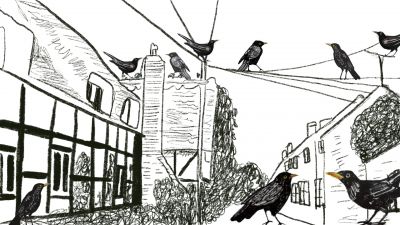
Shocking statistics tell us that some bird species have declined by over 50 per cent in the last few decades and Harry reflected on this as he stepped out into his garden on the first day of lockdown.
Harry describes himself as an amateur naturalist but after a life-long interest in wildlife and a very active role in the Worcestershire Wildlife Trust for over 50 years, there’s little Harry doesn’t know about nature. He was pretty busy during lockdown. As people in Worcester spent more time in their gardens, they noticed things they hadn’t seen before and sent photos to the Wildlife Trust for identification. Harry also kept a record of things in his own garden every day, as well as spending time at a nearby reserve which he manages for the Trust on a voluntary basis.
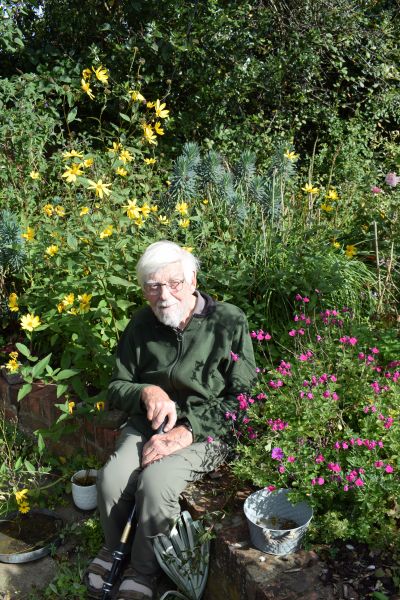
When recalling his time in isolation, Harry confessed to Julia that, ‘A big green shiny beetle that I’ve been obsessed with for years really helped me get through lockdown!’ The beetle in question was the rare iridescent Noble Chafer, an insect whose larvae live on rotten wood in old orchards. Harry’s great interest in insects led to him working with the ‘boxes and boxes, drawers and drawers’ of specimens accumulated by the 19th century collector John Edward Fletcher.
These are now in the City Museum and Art Gallery.
Harry said: “We get a lot from comparing what was about in the past with what we see now, Fletcher was an unusual man, his ability to identify all these insects is a mystery to us but the collection is really important to us locally”.
Sarah loved illustrating Harry’s story as the natural world is one of her favourite artistic subjects. She used a range of mixed media including her Japanese brush pens for the blackbirds, felt tip pens for Harry’s garden and pencils to illustrate dawn. She even managed to find some pearlescent green ink to paint Harry’s Noble Chafer Beetle, an unexpected find in her large collection of art materials! She overlaid pastel and ink to create a multi- layered effect on the beetle’s back.
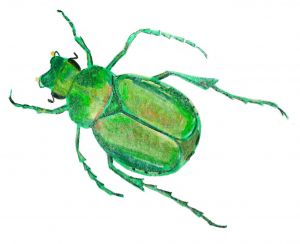
Ava & Cara’s Story
The Art of Isolation: Ava & Cara’s Story, edited by Julia Letts & illustrated by Sarah Millin, 2020.
Copyright the artists
These two girls are best friends and go to Tibberton First School which, like every other school in the country, was closed on March 20th 2020 because of the Corona virus pandemic. We wanted to include young voices to find out what it was like for children whose normal routines were turned upside down by prolonged isolation. Ava and Cara talk about the initial excitement they felt when they were sent home, followed by the realization that they could not see friends and do all the things they love doing. Ava hated missing her football sessions, and Cara her dance lessons. She did some classes online, but she says it wasn’t the same…
Read more
 The girls spent weeks doing their schoolwork from home and staying in touch with friends through Zoom and Whatsapp calls. Although they enjoyed spending more time with their families, playing outside and going on bike rides, they desperately missed their friends. When restrictions relaxed, Ava recalls a special time accompanying her grandpa to the farm where he works. Looking after the animals, she says, changed her life. ‘That was the day I turned Pescatarian!’
The girls spent weeks doing their schoolwork from home and staying in touch with friends through Zoom and Whatsapp calls. Although they enjoyed spending more time with their families, playing outside and going on bike rides, they desperately missed their friends. When restrictions relaxed, Ava recalls a special time accompanying her grandpa to the farm where he works. Looking after the animals, she says, changed her life. ‘That was the day I turned Pescatarian!’
Sadly, Cara’s grandma who had leukemia passed away from Covid-19 during lockdown. Cara has found ways to deal with her feelings and was brave enough to talk about her grandma’s death. She gets comfort from a teddy dressed in a costume made from her grandma’s clothes. When she feels sad, she hugs the teddy to remind her of her beloved grandma.
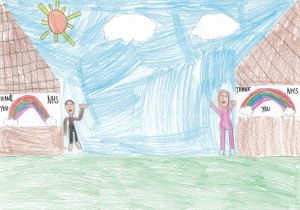 Following the interview with Ava and Cara, we asked their class at Tibberton First School if they would like to illustrate Ava and Cara’s story. The result is a magical collection of drawings which not only bring the recording to life, but also give an insight into the feelings and emotions of the young artists, as they find a way to process the last few, strange months with pen and paper.
Following the interview with Ava and Cara, we asked their class at Tibberton First School if they would like to illustrate Ava and Cara’s story. The result is a magical collection of drawings which not only bring the recording to life, but also give an insight into the feelings and emotions of the young artists, as they find a way to process the last few, strange months with pen and paper.
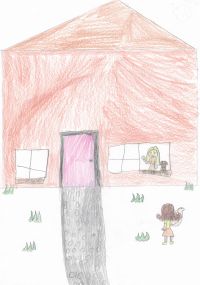
We are delighted to have included the children’s work in the videos and want to say a big thank you to Mrs Turner and her class at Tibberton First School.
Sara’s Story
The Art of Isolation: Sara’s Story, edited by Julia Letts & illustrated by Sarah Millin, 2020.
Copyright the artists
Sara’s story was recorded on a sunny day in August looking out over a beautiful garden on the edge of Castlemorton Common. The garden was created by Richard, Sara’s husband, and was just starting to burst into life in mid-March when Boris Johnson announced lockdown. On 22nd March, Richard, who had been feeling unwell for a few days, became very tired and short of breath. When his condition worsened, Sara called an ambulance.
Read more
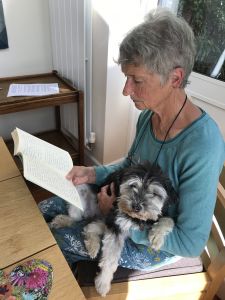
Because of Covid restrictions, she was unable to go with him to the Worcestershire Royal Hospital. She was able to speak to him by phone the next day and tell him how much she loved him but tragically Richard died the following morning.
Julia & Sarah say: “It is hard to imagine a more terrible situation than this, yet Sara bravely agreed to tell us her story to us in the hope that it might help others faced with similar situations. She also wanted her experience to became part of the historic record of the Covid-19 pandemic for future generations. She recalls her mother-in-law talking about the Spanish Flu epidemic in 1919 and regrets that those memories were never documented.
Sara and Richard met through an early online dating company and had been very happily married for 27 years. They bought and restored a cottage on a plot of land in Golden Valley and over the years, Richard transformed the plot into an astonishing garden. Sara insists that it was his creation – she helped, but it was him who lovingly created a series of ‘rooms’ within the garden, each with a different character, beautifully constructed, planted and tended. After Richard’s death, the garden became a burden to Sara but initially it provided her with some solace, as did dog walks with Richard’s little dog Rea.
At the start of lockdown Sara started a diary in which she recorded her thoughts in the early weeks of the pandemic. She continued to write the diary until Easter weekend. Sara agreed to record her diary with Julia. It is an extremely eloquent and moving account of her isolation and grief and a reminder of so many little things that we’ve forgotten about in those strange first days of lockdown.
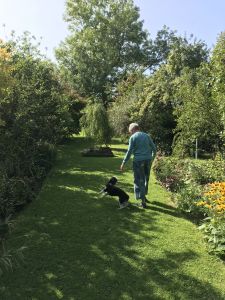
We wanted to share Sara’s story for many reasons. It is a tribute to Richard but also a practical guide to coping when in a total state of shock and unable to be with your loved ones. Little things like caring for a plant, walking the dog and reading poems sent by her daughter kept Sara going, one day at a time.”
Sarah’s artistic response to Sara’s story was very thoughtful. She too had experienced a recent close bereavement and could identify with the confusion of emotions, intensity and sadness. She did not want the colour palette to go too dark as including colour suggested hope. Where she used black, she also introduced purple and magenta and found it interesting to create a moving pattern to illustrate the waves of sadness and bereavement.
Sara’s daughter is an artist and in the weeks after Richard’s death she painted the tulips outside the cottage, an act that Sara found both therapeutic and inspiring. ‘It caught the moment,’ she says. The painting, in water colour and wax resist, was made into cards which Sara sent to friends and relatives.
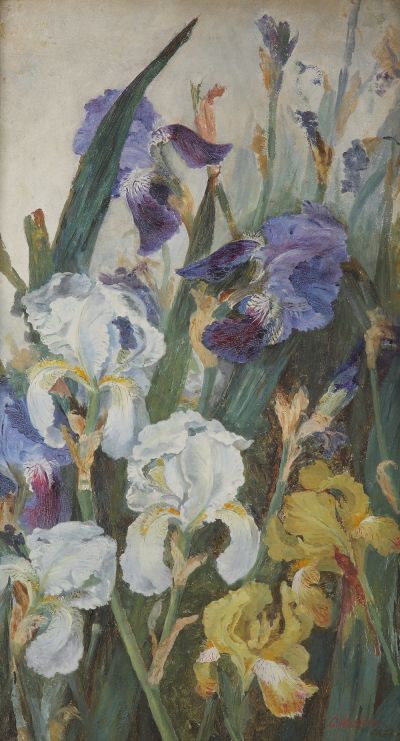
Charlotte Hodder – Irises, 1882. C. Museums Worcestershire Collection.
The picture reminded us of a beautiful oil painting in the Art Gallery’s collection called ‘Irises’ (1882), by Charlotte Hodder. Charlotte and her husband Albert were art master & mistress at the Victoria Institute, the current site of Worcester City Art Gallery and Museum. There are several artworks by Charlotte and Albert in the collection, and objects associated with their careers, including a wonderful silver medal awarded to Charlotte.
The poem Sara reads is by Lemn Sissay. Music on Sara’s story from Zapsplat.
Other things you might like…
From the Art Gallery with Love x
Nilupa Yasmin – Something Old, Something New online exhibition
Sarah Leavesley – Mosaic of Modern Worcestershire exhibition
Susan Birth – Echoes of Ancient Art exhibition
Steve Wilson & Sarah Edwards – Wilson & Edwards: Purveyors of Heritage & Wisdom video series
Tell us what you think!
We’re eager to know what you’re enjoying about the online content we’re providing during the pandemic, and what we should do more of. Click here to let us know. It only takes a couple of minutes, but will be a big help to us.



